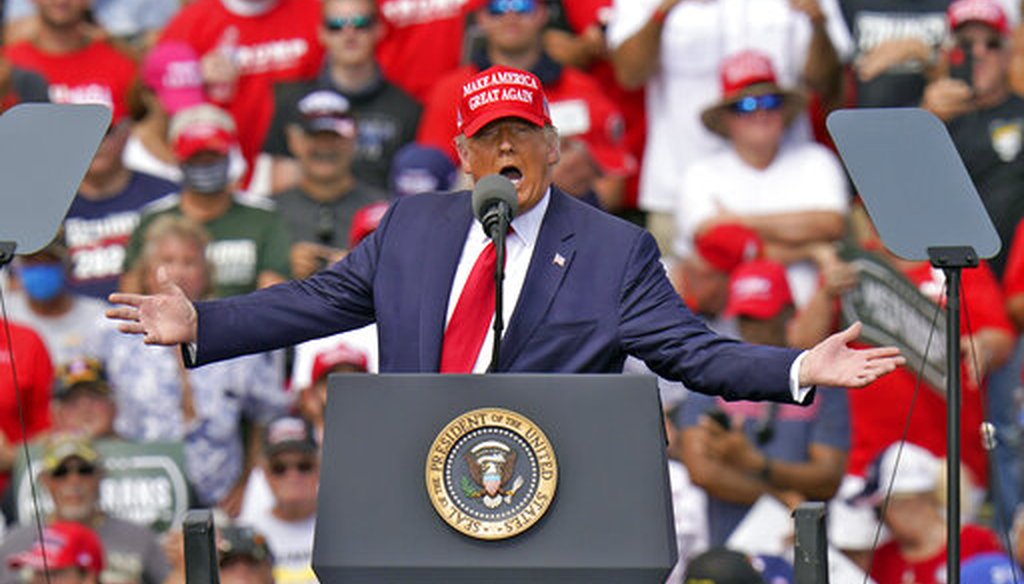Stand up for the facts!
Our only agenda is to publish the truth so you can be an informed participant in democracy.
We need your help.
I would like to contribute

President Donald Trump gestures during a campaign rally Thursday, Oct. 29, 2020, in Tampa, Fla. (AP)
If Your Time is short
-
Trump’s falsehoods about voting by mail are designed to sow doubt in the election, experts said.
-
Voter fraud, including by mail, is statistically rare.
-
Elections officials have heard questions from voters who question the integrity of mail ballots.
The pandemic forced an unprecedented overhaul of election practices to keep voting safe. Supervisors scrambled to buy sneeze guards, gloves and massive amounts of hand sanitizer. They planned a dramatic expansion of voting by mail.
But no amount of disinfectant wipes could clean up President Donald Trump’s false attacks on the integrity of the vote.
Trump portrayed voting by mail as a fraudulent caper orchestrated by nefarious actors — part of the plot to rig election ballots against him.
"Will they be forged? Who is signing them?" Trump said in July about California’s plan to send ballots to all voters. "Will they be counterfeited by groups inside our nation?"
So far, the early voting turnout in person and by mail shows the U.S. could surpass turnout rates from the past few presidential elections. Even if that happens, stakeholders from national groups and election offices say it doesn’t erase the harm caused by Trump’s misleading attacks on voting.
"This is designed to create doubt, chaos, and mistrust in the system," said Amber McReynolds, CEO of the National Vote at Home Institute. "It's similar to what foreign actors attempt to do when they interfere with disinformation about the process."
Trump ramped up his attacks as virus hit US
In April, Trump called mail-in voting "horrible" and "corrupt" and alleged that "you get thousands and thousands of people sitting in somebody’s living room, signing ballots all over the place."
We rated Trump’s statement False. Experts said that voting by mail does provide a greater potential for ballot fraud than in-person voting, but it is statistically rare.
Over the next few months, Trump and his allies proceeded on two fronts: They encouraged their own voters to cast ballots by mail, while attacking the option in court and in public.
Trump usually aimed his critiques at Democratic-led battleground states or states that expanded voting by mail for the pandemic.
During a September rally in Nevada, Trump said Gov. Steve Sisolak, a Democrat, is "in charge of the election and the millions of ballots. So if I’m up like millions of votes, he can rig the election, he can rig the election."
The idea that Sisolak could "rig" the election is ludicrous. The day-to-day tasks of operating an election are in the hands of county officials, not a governor.
Trump has ignored the evidence by his own federal government about the lack of widespread voter fraud. FBI director Christopher Wray testified in September that "we have not seen historically any kind of coordinated national voter fraud effort in a major election whether it’s by mail or otherwise."
Trump has highlighted some errors in the printing or mailing of ballots, but he overblows them. At a Pennsylvania rally as he railed against "phony" ballots, Trump said that ballots had been printed without his name on them.
Mostly False. In one Los Angeles precinct, ballots mistakenly omitted the presidential race entirely, which means Biden’s name was missing too. The faulty ballots were mailed to just over 2,100 voters out of more than 5.6 million registered voters in the county. Elections officials sent replacements.
"Isolated issues are expected in any large election, but they impact only a small number of voters," said Matthew Weil, a voting expert at the Bipartisan Policy Center.
Experts say that Trump’s rhetoric gives power to adversaries who relish the opportunity for distrust in U.S. elections.
"Dictators around the globe would like nothing more than for citizens in a democracy to lose faith in democracy as a political system, and to believe that their votes won’t count, and don’t matter," said David Becker, executive director of the Center for Election Innovation & Research.
RELATED: What we know about 2020 election interference (it’s not just Russia)
Despite Trump’s rhetoric, voting by mail has remained popular
Trump’s rhetoric is leading to more questions and skepticism from voters as they interact with elections staff on the ground.
Pinellas County, a battleground county on Florida’s west coast, has long been run by Republican supervisors of elections who have advocated for voting by mail. This summer, elections officials sent an email and postcard to voters who hadn’t signed up for a vote by mail ballot.
"We received dozens of responses from voters who suggested they believed that voting by mail was fraudulent," said Dustin Chase, spokesperson for Julie Marcus, the Republican elections supervisor.
Some voters sent back the postcards with hand-scrawled messages such as "mail in ballots promote fraud" or "dangerous no no no." One voter scratched out the phrase vote by mail and wrote "go vote."
Pinellas sent a similar mailer in 2018 and did not receive poor feedback. Despite some negative reactions, as of mid-afternoon Oct. 30, more than three times as many voters in Pinellas have cast ballots by mail ahead of Nov. 3 than at in-person early voting sites.
In Texas’ Harris County, which includes the city of Houston, the questions about the integrity of vote by mail ballots have come from voters, as well as politicians who have received phone calls from their constituents about voting by mail.
"A congressman called me to ask if people could vote twice," said Chris Hollins, county clerk since June. The congressman knew that voting twice was illegal, but he wanted to know if there was a mechanism that would allow it to happen. Trump created confusion over his comments in North Carolina urging voters to show up at in person sites to see if their mail ballots were counted.
"It’s been quite a burden on our call centers and all of our voter outreach team to put misinformation to rest to ensure people that voting by mail is secure, fraud related to voting by mail is extraordinarily rare," Hollins said.
Some counties have seen voters continue to use voting by mail at high rates, but they’re dropping off their ballots at in-person sites or ballot drop boxes.
In Lee County, a Republican-leaning county in Florida, about 65,000 voters had dropped off their mail ballots nearly one week before Election Day, said Supervisor of Elections Tommy Doyle. In past election years, only hundreds chose that option to return their ballot.
"People dropping off ballots say, ‘I want to make sure this counts, that’s why I’m dropping it off’," Doyle said.
Our Sources
Richard Hasen, Professor of Law and Political Science at the University of California, Irvine, op-ed in New York Times, Trump’s Relentless Attacks on Mail-In Ballots Are Part of a Larger Strategy, Aug. 19, 2020
AP, Trump casts doubt on mail voting. His campaign promotes it. May 12, 2020
Sarah Cooper, Mail-in Voting at the Democratic National Convention, Aug. 26, 2020
WRAL, GOP mailer pitches voting by mail despite president's 'Rigged Election!!!' rhetoric, July 24, 2020
White House, Remarks by President Trump at a Turning Point Action Address to Young Americans, June 23, 2020
Milwaukee Journal Sentinel, Haynes: Wisconsin's election may have been 'ridiculous' but those who braved coronavirus to vote were anything but, April 9, 2020
Miami Herald/Tampa Bay Times, Trump says mail ballots are terrible. But Florida GOP relies on them. April 8, 2020
President Donald Trump, Tweet, Aug. 4, 2020
Brennan Center for Justice, Voting Rights Litigation 2020
Stanford-MIT Health Elections Project, Mail voting litigation during the coronavirus pandemic, Oct. 28, 2020
C-SPAN, Clip of FBI director Christopher Wray, Sept. 24, 2020
Telephone interview, Chris Hollins, Harris County, Texas county clerk, Oct. 28, 2020
Email interview, David Becker, executive director of the Center for Election Innovation & Research, Oct. 28, 2020
Telephone interview, Dustin Chase, spokesperson for Pinellas County Supervisor of Elections, Oct. 28, 20220
Telephone interview, TJ Pyche, spokesperson for Alachua County Supervisor of Elections, Oct. 28, 2020
Telephone interview, Tommy Doyle, Lee County Supervisor of Elections, Oct. 28, 2020
Email interview, Amber McReynolds, CEO of Vote at Home, Oct. 27, 2020
Email interview, Matthew Weil, director of the elections project at the Bipartisan Policy Center, Oct. 28, 2020
Email interview, Interview, Justin Levitt, Loyola Law school professor, Oct. 28, 2020
PolitiFact, Fact-checking the integrity of the vote in 2016, Dec. 17, 2016
PolitiFact, Donald Trump’s dubious claim that 'thousands' are conspiring on mail-ballot fraud, April 9, 2020
PolitiFact, Trump falsely claims Michigan illegally sent ballots to all voters, May 20, 2020
PolitiFact, No, California Is Not Sending Mail-In Ballots "To Anyone In The State," As Trump Falsely Claimed, May 26, 2020
PolitiFact, Donald Trump draws false distinction between absentee, mail-in voting, July 31, 2020
PolitiFact, Trump tweet mischaracterizes New York’s voting woes, Aug. 14, 2020
PolitiFact, Donald Trump says Joe Biden can only win by a 'rigged election.' That's wrong in several ways, Aug. 24, 2020
PolitiFact, Trump’s falsehoods about mail voting in Nevada, fact-checked, Sept. 13, 2020
PolitiFact, Trump exaggerates North Carolina ballot mishap, Sept. 22, 2020
PolitiFact, Fact-checking Trump’s debate comment that poll watchers were ‘thrown out’ of Philly polling places, Oct. 1, 2020
PolitiFact, Trump whiffs describing Wisconsin ballot case, Oct. 9, 2020
PolitiFact, Ballot drop boxes have long been used without controversy. Then Trump got involved, Oct. 16, 2020
PolitiFact, Fact-checking Trump’s overblown statement about ballots missing his name, Oct. 21, 2020
PolitiFact, Donald Trump says you can change your vote in most states. That’s misleading, Oct. 27, 2020
PolitiFact, Trump’s misleading claim about ballot signatures in Nevada, Oct. 28, 2020
PolitiFact, Donald Trump wrong that a winner has to be announced Election Night, Oct. 28, 2020












































